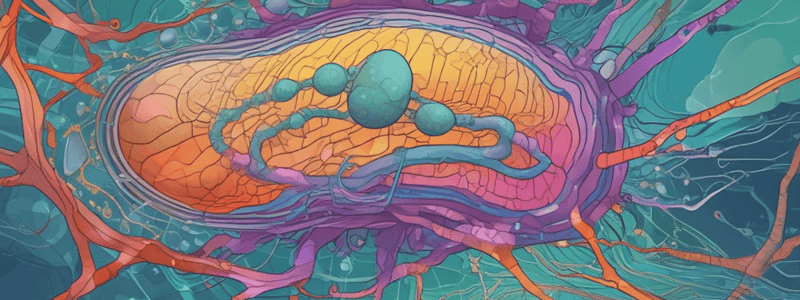Podcast
Questions and Answers
What is the primary function of the cell membrane?
What is the primary function of the cell membrane?
- To produce energy for the cell
- To facilitate the diffusion of molecules across the cell
- To provide a semipermeable barrier between the inside and outside of the cell (correct)
- To regulate the movement of molecules through the membrane
What determines whether a molecule can cross the cell membrane?
What determines whether a molecule can cross the cell membrane?
- The interaction of the molecule with the cell's cytoskeleton
- The presence of temporary holes in the membrane
- The concentration gradient of the molecule
- The size and polarity of the molecule (correct)
Why can small nonpolar molecules easily cross the cell membrane?
Why can small nonpolar molecules easily cross the cell membrane?
- Because they have a charge
- Because they are always in a high concentration
- Because they are large and can fit through the membrane
- Because they interact favorably with the nonpolar lipids (correct)
What is the primary mechanism by which molecules like water, oxygen, and carbon dioxide cross the cell membrane?
What is the primary mechanism by which molecules like water, oxygen, and carbon dioxide cross the cell membrane?
What is the main reason why large polar molecules and molecules with a charge cannot cross the cell membrane?
What is the main reason why large polar molecules and molecules with a charge cannot cross the cell membrane?
What is true about molecules that are larger or have a charge?
What is true about molecules that are larger or have a charge?
Flashcards are hidden until you start studying
Study Notes
Cell Membrane Structure and Function
- The cell membrane provides a semipermeable barrier between the inside and outside of the cell, regulating the movement of molecules through the membrane.
Diffusion Across the Membrane
- Molecules tend to spread out, but some are blocked by the semipermeable cell membrane.
- Factors that determine if a molecule can cross the membrane include:
- Size of the molecule
- Polarity or charge of the molecule
- Small nonpolar molecules can easily cross the membrane because they interact favorably with nonpolar lipids.
- Small polar molecules can pass through small temporary holes in the membrane, despite poor interaction with lipids.
- Large polar molecules and molecules with a charge cannot cross the membrane due to their size and poor interaction with lipids.
- Molecules such as water, oxygen, and carbon dioxide can cross the cell membrane using simple diffusion, following their concentration gradient.
- Larger molecules or those with a charge require alternative mechanisms to cross the membrane.
Studying That Suits You
Use AI to generate personalized quizzes and flashcards to suit your learning preferences.




